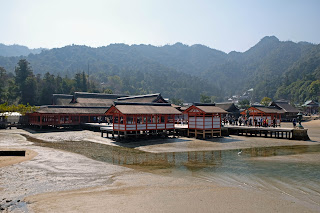I've realized that I must be a bit of a harsh taskmaster--I just looked at my phone, and apparently over the 10-day trip I made my family walk over 15,000 steps a day.
I maintain that it's good for you.
Our second day in Hiroshima was no exception, when I brought everyone to Miyajima, the "Shrine Island" on the Seto Inland Sea. Not only is it only a short way away from Hiroshima City, it has one of the most beautiful shinto shrines I know of, Itsukushima.
The shrine has likely existed on the island in some form since the 6th century (and, like so many structures in Japan, has been burnt/destroyed and rebuilt several times-- what is "authenticity" anyways?).
The current structure of Itsukushima is similar to the shinden architecture--a main building connected to other smaller structures via corridors--that was often used during the Heian Period (794-1185) for aristocratic mansions.
The island overall was controlled by the Taira, a major samurai clan. Miyajima was one of their important religious sites, dedicated to a sea dragon deity. Although it was originally a "pure" shinto site, in the early 12th century an elaborate picture scroll of the Lotus Sutra and other Buddhist texts was commissioned by the family and gifted to the shrine.
Fitting for a sea dragon deity, the torii gate for Itsukushima appears to "float" in the sea during high tide. Since the island is considered such a holy place you used to have to enter by guiding your boat through the gate before making land. (Side note: even today the island is supposed to remain free of the purity of birth and death; pregnant women are supposed to leave the island when their due date approaches, as are the terminally ill. There are also no people interred on Miyajima.) The massive JR ferries that bring people back and forth can't pass through the gate, but coming into the island is still an awe-inspiring experience.
 |
| View of the torii during mid-tide. |
The rest of the island itself is charming, with many smaller temples and shrines, hiking trails, parks, onsen (hot spring) resorts, and winding streets where you can grab some of the island's specialty oysters or piping hot momiji manju (sponge cake filled with red bean or some other delightful filling and shaped like a maple leaf).
The highlight (besides the inquisitive deer!) is the shrine.
We had pretty spectacular timing. In the morning the tide was high, but by the afternoon the tide had rolled out and we could walk all the way out to the torii. It's 16 meters tall (52 feet)! Walking out there and realizing that you were walking "on" the sea floor was a bit of a weird experience. Comparing the water markings to my own height, at high tide the entire plain would be covered in water higher than I am tall...
 |
| Detail of one of the massive decay-resistant camphor tree pillars. |
 |
| The view of the main shrine from the torii. |
Another fun fact about Miyajima is that apparently the origin of the shamoji: the utensil you use to scoop up rice. The "world's largest" shamoji is on display and you can buy little ones as souvenirs.
I can only imagine some giant dragon god needing a scoop this big for his bowl of rice!












Comments
Post a Comment